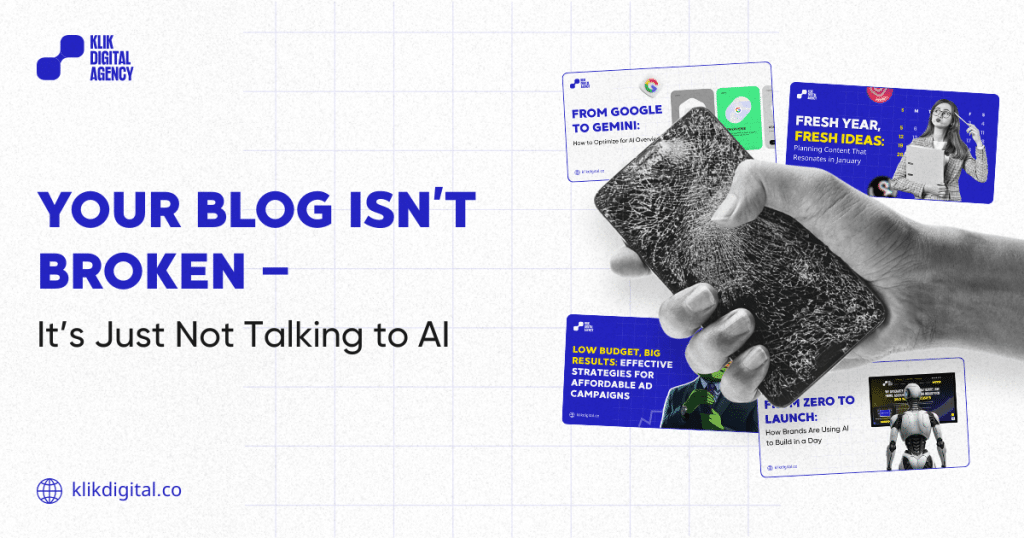Your Blog Isn’t Broken – It’s Just Not Talking to AI
Subscribe to our newsletter
Keep up with the latest news in the digital marketing arena with Klik Digital. Subscribe Now!

In 2025, noticing a sudden dip in your blog traffic can feel alarming. You’ve followed SEO best practices for years—compelling headlines, meta tags, backlinks—but now your posts are barely showing up in search results. Before you panic, here’s the good news: your blog isn’t broken. It just isn’t speaking the language AI-driven search engines understand.
Traditional SEO focused on keywords, links, and user signals. Modern AI-first search engines—think Google’s SGE, ChatGPT-powered summaries, or Perplexity—look beyond keywords. They read, analyze, and summarize content, prioritizing structured, fact-rich, and entity-based information. If your blog isn’t optimized for these AI “crawlers,” it might be invisible in the very channels your audience now uses to discover content.
How AI Reads Content vs. Humans
Humans skim, scan, and interpret meaning contextually. AI, by contrast, uses entity extraction, structured data, and fact verification to evaluate content. It doesn’t just look at a headline or paragraph; it parses definitions, links concepts, and identifies authoritative sources.
Key differences include:
- Entity extraction: AI identifies people, places, products, and concepts in your text and connects them to knowledge graphs.
- Fact-checking: Generative engines cross-reference claims with trusted sources.
- Structured snippets: AI prefers content organized with headings, tables, FAQs, and lists that can be summarized into concise answers.
Without these elements, even high-quality content can remain invisible to AI-driven search.
The Rise of Generative Search
Generative search platforms have fundamentally changed how people find information. Instead of scrolling through 10 blue links, users ask an AI system a question and receive a synthesized answer drawing from multiple sources. Examples include:
- Google SGE (Search Generative Experience): Summarizes content from multiple pages, highlighting the most authoritative sources.
- ChatGPT and Perplexity: Answer complex questions with concise, cite-able explanations.
- Other AI summarizers: Combine content from blogs, research papers, and media outlets to produce one coherent response.
In this environment, blogs that aren’t AI-optimized risk being skipped entirely in these AI-generated answers.

Why Blogs Fail to Show Up in AI Results
When blogs don’t show up in AI-driven search results, it’s rarely because the content is bad—it’s usually because AI simply can’t “read” it the way it reads other sources. Dense, unstructured paragraphs and missing headings make it hard for AI to parse your key points. Posts without clear definitions or FAQ-style explanations leave AI guessing what each concept means.
Inconsistent terminology—switching names, acronyms, or references—confuses AI about what your content is actually describing. And without authoritative citations, AI has little reason to trust or reference your work. In short, a blog that delights human readers might still be invisible to the machines summarizing the web.
How to “Talk” to AI with Your Blog
Optimizing for AI doesn’t mean sacrificing your voice—it means adding structure and clarity so AI can understand and cite your work. Key strategies include:
- Schema markup: Add structured data for articles, FAQs, and products.
- FAQs and Q&A headings: Break H2/H3 headings into questions that AI can extract directly.
- Glossary terms: Clearly define industry-specific concepts to improve entity recognition.
- Tables and bulleted lists: Summarize key points for AI-friendly parsing.
- Consistent entities: Use the same terminology for people, products, and concepts throughout your posts.
- Citations and authoritative links: Link to credible sources to boost AI trust in your content.
These steps help your blog become a knowledge source AI wants to read, reference, and summarize.
Balancing AI and Human Optimization
Writing for AI doesn’t mean writing for robots. Humans still crave storytelling, examples, and engaging narratives. The key is dual optimization:
- Use clear headings, structured data, and FAQs for AI.
- Maintain engaging introductions, anecdotes, and natural flow for readers.
When done right, your blog satisfies both audiences—AI engines reward your content with visibility, while humans stay interested and engaged.

Quick Wins to Make Blogs AI-Ready
You don’t need to rewrite every post from scratch. Start with:
- Refreshing old content: Add definitions, tables, and updated links.
- Adding FAQ blocks: Turn common questions into H2/H3 sections.
- Structuring content: Use headings consistently and logically.
- Citing authoritative sources: Link to research papers, industry reports, and recognized publications.
Even small changes can significantly boost your AI-first search visibility.
The Future of Blogs in an AI-Driven World
By 2025 and beyond, blogs are no longer just marketing assets—they’re knowledge hubs. Companies that optimize for AI not only retain organic traffic but also become trusted sources that generative engines reference repeatedly. The blogs that succeed will be:
- Fact-rich and structured for AI.
- Story-driven and engaging for humans.
- Continuously updated and authoritative.
AI optimization is not a threat—it’s a chance to amplify your reach and influence.
Your blog can thrive in an AI-first world. Book a Consultation on Generative Engine Optimization to start optimizing today.
FAQ

Traffic drops often happen because AI-driven search now summarizes content, favoring structured, entity-rich blogs over traditional keyword-heavy posts.
SEO focuses on keywords, backlinks, and click-through rates. AI optimization emphasizes structured content, definitions, FAQs, and credible citations that AI can parse and summarize.
Check if your posts have clear headings, FAQs, glossary terms, tables, and consistent entity usage. AI-friendly blogs are easily parsed and cite-able by generative engines.
Not necessarily. Strategic updates—adding structure, FAQs, and citations—can make existing content AI-ready without full rewrites.
No. Blogs remain valuable for storytelling, context, and in-depth analysis. Optimizing for AI simply ensures your content remains visible and trusted in a new search landscape.








